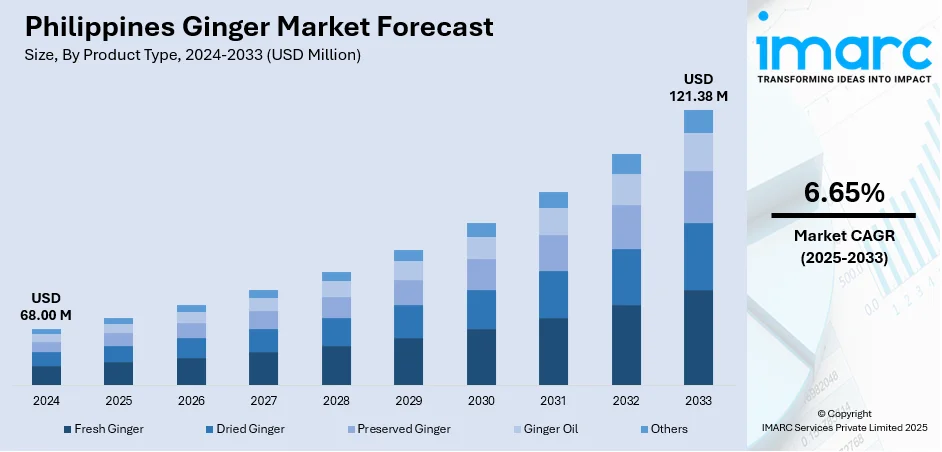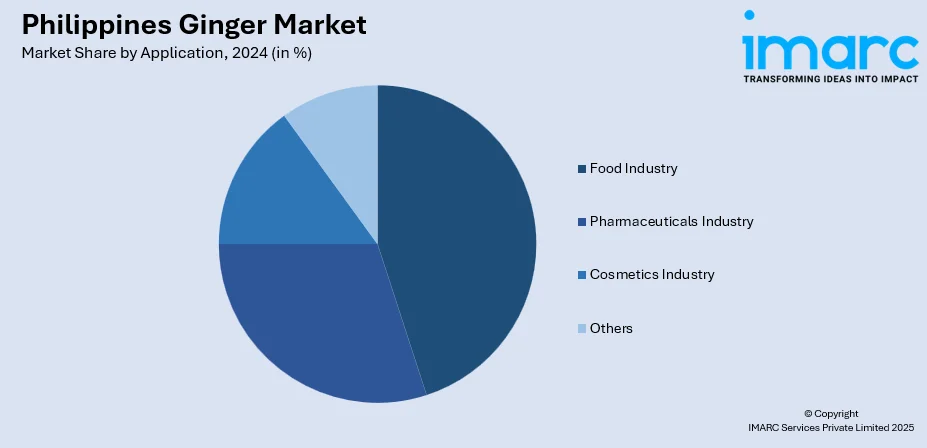
Philippines Ginger Market Size, Share, Trends and Forecast by Product Type, Application, Distribution Channel, and Region, 2025-2033
Philippines Ginger Market Overview:
The Philippines ginger market size reached USD 68.00 Million in 2024. The market is projected to reach USD 121.38 Million by 2033, exhibiting a growth rate (CAGR) of 6.65% during 2025-2033. The market is experiencing steady growth as demand rises across various sectors including food, health, and wellness. Consumers are growingly looking for natural and functional ingredients, leading to growing interest in ginger-based foods in their raw and processed states. The market is responding to shifting inclinations through innovation, enhanced accessibility, and broader distribution, including conventional retail and internet. With changing uses and increased recognition of its health implications, new entrants are coming into and defining the Philippines ginger market share.
|
Report Attribute
|
Key Statistics
|
|---|---|
|
Base Year
|
2024
|
|
Forecast Years
|
2025-2033
|
|
Historical Years
|
2019-2024
|
| Market Size in 2024 | USD 68.00 Million |
| Market Forecast in 2033 | USD 121.38 Million |
| Market Growth Rate 2025-2033 | 6.65% |
Philippines Ginger Market Trends:
Shifting Production Leadership
Across the Philippines, ginger farming is gaining new momentum as both public programs and local farming communities align their efforts. What used to be seen as a modest backyard crop is now being cultivated with more purpose and structure. In May 2025, government recognition spotlighted Nueva Vizcaya as a key contributor to national production, bringing attention to the potential for ginger to become a stronger economic driver in agricultural zones. This move reflects a wider trend where institutional support is gradually turning into tangible action on the ground from better access to farming inputs to increased technical training and market linkage efforts. In provinces with suitable soil and climate, farmers are beginning to see ginger as a reliable, scalable crop that doesn’t just serve household consumption but also meets demand from processors and retailers. With more local leaders and cooperatives stepping into space, there’s growing confidence that ginger can support both livelihoods and market supply chains. All signs point to a steady rise in momentum, supporting long-term Philippines ginger market growth.

To get more information on this market, Request Sample
Growing Institutional and Community Engagement
Support for ginger cultivation in the Philippines is becoming more hands-on, with government programs and local communities working more closely than ever to strengthen production. In late 2024, efforts to distribute improved ginger seedlings under national initiatives began reaching more farmers, especially in provinces where ginger is increasingly seen as a high-potential crop. These efforts go beyond material assistance as they reflect a shift in mindset around what crops can offer real, scalable value in rural development. Farmers receiving planting materials are also gaining access to guidance on soil preparation, disease control, and post-harvest handling, making it easier to produce ginger more efficiently and with higher quality. As knowledge sharing expands, so does farmer confidence, encouraging more to shift land toward ginger production. On a broader level, this kind of institutional support signals that ginger is no longer peripheral, it’s part of a national agenda to diversify crops and improve farmer income. With communities increasingly engaged and policy support strengthening, these developments are creating strong foundations for sustainable Philippines ginger market.
Stabilization Efforts and Market Balance
In recent years, maintaining a steady supply of ginger in the Philippines has become more than just an agricultural concern it’s now part of a broader conversation around food security and price control. In October 2024, government agencies responded to sudden price increases in wet markets by coordinating ginger imports from neighboring countries. This move aimed to ease pressure on both consumers and local supply chains. While importation can be a short-term fix, it also reflects a more mature market response to volatility. Rather than allowing shortages or price spikes to disrupt access, authorities are beginning to treat ginger like a core commodity, with mechanisms in place to ensure availability year-round. These steps help protect both household budgets and small businesses that rely on consistent pricing. More importantly, they highlight how ginger is no longer viewed as just another spice, it's now part of a managed system balancing local output with strategic sourcing. As production and supply coordination improve, so does market reliability, setting the tone for more sustainable and resilient Philippines ginger market trends.
Philippines Ginger Market Segmentation:
IMARC Group provides an analysis of the key trends in each segment of the market, along with forecasts at the country and regional levels for 2025-2033. Our report has categorized the market based on product type, application, and distribution channel.
Product Type Insights:
- Fresh Ginger
- Dried Ginger
- Preserved Ginger
- Ginger Oil
- Others
The report has provided a detailed breakup and analysis of the market based on the product type. This includes fresh ginger, dried ginger, preserved ginger, ginger oil, and others.
Application Insights:

- Food Industry
- Pharmaceuticals Industry
- Cosmetics Industry
- Others
A detailed breakup and analysis of the market based on the application has also been provided in the report. This includes food industry, pharmaceuticals industry, cosmetics industry, and others.
Distribution Channel Insights:
- Traditional Retail
- Modern Retail Stores
- Others
The report has provided a detailed breakup and analysis of the market based on the distribution channel. This includes traditional retail, modern retail stores, and others.
Regional Insights:
- Luzon
- Visayas
- Mindanao
The report has also provided a comprehensive analysis of all the major regional markets, which include Luzon, Visayas, and Mindanao.
Competitive Landscape:
The market research report has also provided a comprehensive analysis of the competitive landscape. Competitive analysis such as market structure, key player positioning, top winning strategies, competitive dashboard, and company evaluation quadrant has been covered in the report. Also, detailed profiles of all major companies have been provided.
Philippines Ginger Market Report Coverage:
| Report Features | Details |
|---|---|
| Base Year of the Analysis | 2024 |
| Historical Period | 2019-2024 |
| Forecast Period | 2025-2033 |
| Units | Million USD |
| Scope of the Report |
Exploration of Historical Trends and Market Outlook, Industry Catalysts and Challenges, Segment-Wise Historical and Future Market Assessment:
|
| Product Types Covered | Fresh Ginger, Dried Ginger, Preserved Ginger, Ginger Oil, Others |
| Applications Covered | Food Industry, Pharmaceuticals Industry, Cosmetics Industry, Others |
| Distribution Channels Covered | Traditional Retail, Modern Retail Stores, Others |
| Regions Covered | Luzon, Visayas, Mindanao |
| Customization Scope | 10% Free Customization |
| Post-Sale Analyst Support | 10-12 Weeks |
| Delivery Format | PDF and Excel through Email (We can also provide the editable version of the report in PPT/Word format on special request) |
Key Questions Answered in This Report:
- How has the Philippines ginger market performed so far and how will it perform in the coming years?
- What is the breakup of the Philippines ginger market on the basis of product type?
- What is the breakup of the Philippines ginger market on the basis of application?
- What is the breakup of the Philippines ginger market on the basis of distribution channel?
- What is the breakup of the Philippines ginger market on the basis of region?
- What are the various stages in the value chain of the Philippines ginger market?
- What are the key driving factors and challenges in the Philippines ginger market?
- What is the structure of the Philippines ginger market and who are the key players?
- What is the degree of competition in the Philippines ginger market?
Key Benefits for Stakeholders:
- IMARC’s industry report offers a comprehensive quantitative analysis of various market segments, historical and current market trends, market forecasts, and dynamics of the Philippines ginger market from 2019-2033.
- The research report provides the latest information on the market drivers, challenges, and opportunities in the Philippines ginger market.
- Porter's five forces analysis assist stakeholders in assessing the impact of new entrants, competitive rivalry, supplier power, buyer power, and the threat of substitution. It helps stakeholders to analyze the level of competition within the Philippines ginger industry and its attractiveness.
- Competitive landscape allows stakeholders to understand their competitive environment and provides an insight into the current positions of key players in the market.
Need more help?
- Speak to our experienced analysts for insights on the current market scenarios.
- Include additional segments and countries to customize the report as per your requirement.
- Gain an unparalleled competitive advantage in your domain by understanding how to utilize the report and positively impacting your operations and revenue.
- For further assistance, please connect with our analysts.
 Request Customization
Request Customization
 Speak to an Analyst
Speak to an Analyst
 Request Brochure
Request Brochure
 Inquire Before Buying
Inquire Before Buying




.webp)




.webp)












